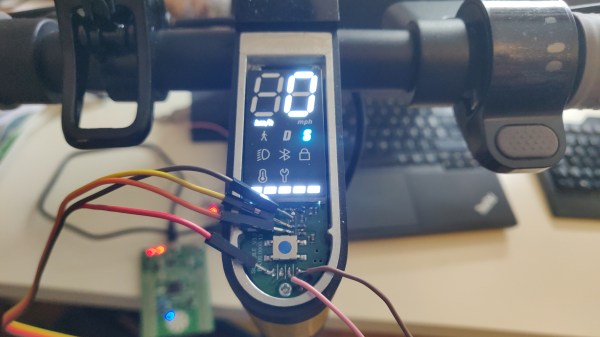Four years ago when the idea of a pandemic was something which only worried a few epidemiologists, a group of British hardware hackers and robotic combat enthusiasts came up with an idea. They would take inspiration from the American Power Racing Series to create their own small electric racing formula. Hacky Racers became a rougher version of its transatlantic cousin racing on mixed surfaces rather than tarmac, and as an inaugural meeting that first group of racers convened on a cider farm in Somerset to give it a try. Last weekend they were back at the same farm after four years of Hacky Racer development with racing having been interrupted by the pandemic, and Hackaday came along once more to see how the cars had evolved. Continue reading “How Far Can You Push A £500 Small Electric Car; Four Years Of The Hacky Racer”
Xiaomi Cryptographically Signs Scooter Firmware – What’s Next?
[Daljeet Nandha] from [RoboCoffee] writes to us, sharing his research on cryptographic signature-based firmware authenticity checks recently added to the Xiaomi Mi scooter firmware. Those scooters use an OTA firmware update mechanism over BLE, so you can update your scooter using nothing but a smartphone app – great because you can easily get all the good new features, but suboptimal because you can easily get all the bad new features. As an owner of a Mi 1S scooter but a hacker first and foremost, [Daljeet] set up a HTTPS proxy and captured the firmware files that the app downloaded from Xiaomi servers, dug into them, and summarized what he found.

Unlike many of the security measures we’ve seen lacking-by-design, this one secures the OTA firmware updates with what we would consider the industry standard – SHA256 hash with elliptic cryptography-backed signing. As soon as the first firmware version implementing signature checks is flashed into your scooter, it won’t accept anything except further firmware binaries that come with Xiaomi’s digital signature. Unless a flaw is found in the signature checking implementation, the “flash a custom firmware with a smartphone app” route no longer seems to be a viable pathway for modding your scooter in ways Xiaomi doesn’t approve of.
Having disassembled the code currently available, [Daljeet] tells us about all of this – and more. In his extensive writeup, he shares scripts he used on his exploration journey, so that any sufficiently motivated hacker can follow in his footsteps, and we highly recommend you take a look at everything he’s shared. He also gives further insights, explaining some constraints of the OTA update process and pointing out a few security-related assumptions made by Xiaomi, worth checking for bypassing the security implemented. Then, he points out the firmware filenames hinting that, in the future, the ESC (Electronic Speed Control, responsible for driving the motors) board firmware might be encrypted with the same kind of elliptic curve cryptography, and finds a few update hooks in the decompiled code that could enable exactly that in future firmware releases.
One could argue that these scooters are typically modified to remove speed limits, installed there because of legal limitations in a variety of countries. However, the legal speed limits are more nuanced than a hard upper boundary, and if the hardware is capable of doing 35km/h, you shouldn’t be at mercy of Xiaomi to be able to use your scooter to its full extent where considerate. It would be fair to assert, however, that Xiaomi did this because they don’t want to have their reputation be anywhere near “maker of scooters that people can modify to break laws with”, and therefore we can’t expect them to be forthcoming.
Furthermore, of course, this heavily limits reuse and meaningful modification of the hardware we own. If you want to bring a retired pay-to-ride scooter back to usefulness, add Bluetooth, or even rebuild the scooter from the ground up, you should be able to do that. So, how do we go around such restrictions? Taking the lid off and figuring out a way to reflash the firmware through SWD using something like a Pi Pico, perhaps? We can’t wait to see what hackers figure out.
Ask Hackaday: Would A Scooter Get You Back To The Office?
So we’re two plus years into the pandemic at this point. Are you still working from home in the most comfortable clothes ever sewn? We figure that of the lot of you who said goodbye to that drab, tiled carpet in 2020, most have probably heard rumblings about returning to the office. And probably a good portion have at least been forced into a hybrid schedule.
Lots of companies would love to see their employees once again milling about all those glass and steel observation tanks office buildings they pay so much for. And while some are likely just forcing employees to come back, others are offering incentives, such as Google. The tech giant recently partnered with electric scooter manufacturer Unagi to provide a “Ride Scoot” program designed to lure many of Google’s US-based employees back to those brightly-colored code playgrounds they call offices with a fun mode of private transportation. The plan is to offer a full reimbursement of the monthly subscription fee for Unagi’s Model One folding scooter, which retails for $990.
The subscription is normally $49 a month plus a one-time $50 sign-up fee, but this amount will be slightly discounted (and waived) for eligible Google employees. There is one caveat to the system: an employee must use the scooter for a minimum of nine commutes to the office per month, although Google says they’re gonna be a bro about it and use the honor system.
Continue reading “Ask Hackaday: Would A Scooter Get You Back To The Office?”
From Hoverboard To Scooter
I’m sure anyone who had seen Back To The Future was more than a little disappointed when “hoverboards” started appearing on the scene. They didn’t float and they looked fairly ridiculous for anyone over 12. But they have the huge advantage of being cheap and easy to find. [Made By Madman] breaks down a hoverboard for parts to make an incredible custom electric scooter.
The first step after breaking things down for parts was to break the wheel hub motors. He pulled out the axle and started machining a new one using the lathe and a milling machine. A quick temper later, he had a sturdy steel axle. An adapter for a disc brake was milled that could attach to the wheel. The TIG welder came out to weld up a box out of some aluminum to hold the electronics. The wheel had a bracket welded on with a spring shock absorber to help smooth the ride. The fork was machined on the lathe and belt sander, but actual shocks came from an old bicycle. To attach the fork to the frame, [Madman] bends a piece of bar stock into shape; like a madman. The handlebars were taken from the bicycle and the fork was extended up to an adult height.
A quick test ride in the alley showed that the back shock wasn’t strong enough, so he swapped it with a strong one. All the parts got a powder coat. Electronics wise, it has a standard speed controller and a custom battery made from 18650 cells wired up in a 13s6p configuration and bundled together into a package. After a significant amount of wiring, he took it for a test drove and we love seeing him zip around the streets in the snow.
So many parts here are machined to press-fit tolerances and then welded on. The skill, videography, and effort that went into this were just incredible. If you’re feeling inspired and don’t have a lathe on hand, perhaps this 3d printed scooter might be a bit more your speed. Video after the break.
3-Wheeled Electric Skateboard Does Things Differently
Typically, electric skateboards drive one or more wheels with brushless motors, while keeping everything mounted on otherwise fairly-standard trucks to maintain maneuverability. However, [swedishFeetballs] decided to go a different route, building a 3-wheeled design using some interesting parts.
The build relies on a large combined hub motor and wheel, similar to those you would find on a hoverboard or some electric scooters; this one is a Xiaomi part sourced from eBay. It’s controlled via an off-the-shelf electric skateboard speed controller that comes complete with its own remote.
The hardware is all bolted up to a custom skateboard deck built from scratch to accept the large single rear wheel. Up front, a regular skateboard truck is used. Batteries are mounted under the deck. Reportedly, the board has a top speed of 15 mph, which unsurprisingly matches that of the Xiaomi M365 the hub motor is sourced from.
It’s a neat way to build an electric skateboard, and to be honest we couldn’t be more curious as to how it rides. Unfortunately, only a few seconds of footage is available, but we’ve embedded it below for your watching pleasure!
Meanwhile, you might also be curious as to the benefits of a half-track skateboard. Video after the break.
Continue reading “3-Wheeled Electric Skateboard Does Things Differently”
Recycled Parts Round Out Soap Shaped Electric Car
[Handy Geng] has a knack for fitting his creations with a large percentage of recycled material. And as is exemplified by the video below the break, he also loves to mix the practical with the whimsical.
Using parts salvaged from motor scooters, trash heaps, and likely many other sources, [Handy] has put together a small vehicle that he himself describes as looking like a bar of soap as it slips across the floor. You’ll agree when you see the independent front and rear steering at work, allowing the car’s front and rear to be driven and steered on their own. Crabbing sideways, driving diagonally, and we’re guessing spinning in place are possible.
What’s also clear in the video below is that [Handy] is a talented fabricator. While not taking himself too seriously (keep an eye out for the 360° selfie cam!) he clearly takes pride in the work. [Handy]’s workshop and skill set show that at the core, he’s quite serious about his craft. We appreciate the creative use of scrap materials used in such an inspiring build. The turn signals and “communicator” hand is absolutely marvelous.
If building with recycled materials is your thing, then you’ll love the Trash Printer, too. Thanks to [Fosselius] for the tip!
Continue reading “Recycled Parts Round Out Soap Shaped Electric Car”
Electric Mini Rat Rod Starts ‘Em Young
These days, a lot of people barely even say hello to their neighbors. But not [dewey302]. They’re so tight with the people next door that they built this bad-ass electric mini rat rod for the neighbors’ five-year-old kid. Talk about community!
Nearly every bit of this rod is recycled — the body is a wheelbarrow, the transaxle is from a mobility scooter, and the frame was welded together from scrap tubing including the wheelbarrow itself, and old bike or two, and some broken lawn chairs. The rear wheels are also from the ‘barrow, though the front ones were purchased (one of few new parts. Power comes from a pair of 18 V tool batteries wired in series and running through the Curtis controller from the scooter. Depending on the weight of the driver, this baby will do 10-12 MPH.
We love the look of this little rat rod, and wish we were [dewey302]’s neighbor. When you’re done poring over the pile of build pictures, be sure to watch [dewey302] and [The Kid] tear up the cul-de-sac in the video after the break.
You may have noticed the mailbox grille. Surprisingly, this is not the first mail-themed rat rod we’ve covered. Here’s one that really delivers.


















